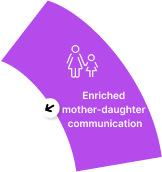The Umang model has been conceptualised with a strategic interplay of women empowerment & leadership
frameworks
and socio-behavioural theories of change.
It relies on
Naila
Kabeer’s
Empowerment Model
that
offers a three-dimensional conceptual approach for women empowerment encompassing Resources (as part
of
the preconditions of empowerment), Agency (as an aspect of process) and Achievement (as a measure of
outcomes).
Kabeer defines empowerment as the process by which those who have been denied the ability
to
make choices acquire such an ability.


Public Policy

Community

Organization

Inter Personal

Mother or
Grandmother of Adolescent Girl


With enhanced awareness, skills and agency (acquired through Umang modular sessions) mothers are participating in household decisions more strongly, especially those around their children.

Modular sessions are enhancing communication & negotiation skills of mothers, making them aware on issues around child marriage, and motivating them to realise their potential as mothers.

Regular & open discussions around daughters’ health, education, and career concerns enable mothers to identify & resolve problems early. Also, their capacities are built to confront problems with external stakeholders.

Increased provision of an enabling environment at household level for daughter’s education and other actions for fulfilling her aspirations

Increased participation of mothers in daughters’ education and school activities

Umang is enriching their regular conversations with discussions around education goals & career aspirations, thus transforming them into meaningful dialogues.
Mothers and daughters are often the closest confidants of each other in households, who mostly spend time together, sharing their experiences and interacting about mundane things regularly. Their strong sense of empathy also arises from confronting similar vulnerabilities and experiences within households and in communities.
Project Umang is enhancing this relationship by strengthening the voices & spaces of mothers and daughters to delay age at marriage & shift norms. It is enabling mothers (who are members of women’s collectives) to realise the incredible role they can play in influencing & shaping their daughters’ future.
Project Umang believes that empowered mothers are better placed in nurturing the rights & aspirations of their daughters. As most mothers (current mothers of adolescent girls) happen to be survivors of child/early marriage themselves, they certainly don’t want their daughters to meet with the same fate. On the other hand, daughters too look up to their mothers for guidance, support and empathy within families. Umang is harnessing these dynamics with the following approach:
CLFs
5-40 VOs

Village Organisations
(VOs) 5-20 SHGs

Self Help Groups
(10-20 Women)
